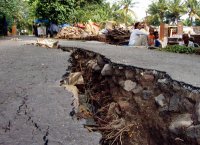
EARTHQUAKES
The Hazard
Earthquakes can be defined as the shaking of earth caused by waves moving on and below the earth's surface and causing: surface faulting, tremors vibration, liquefaction, landslides, aftershocks and/or tsunamis
Aggravating factors are the time of the event and the number and intensity of aftershocks.
Compound hazards are fire, landslide, and tsunami.
Factors of Vulnerability
Man made factors:
- Location of settlements in seismic areas;
- Inadequate building practices and regulations;
- Dense concentration of building with high occupancy;
- The absence of warning systems and lack of public awareness on earthquake risks.
Main Causes of Mortality and Morbidity
Direct Impact
Earthquakes cause high mortality resulting from trauma, asphyxia, dust inhalation (acute respiratory distress), or exposure to the environment (i.e. hypothermia).
Surgical needs are important the first weeks. The broad pattern of injury is likely to be a mass of injured with minor cuts and bruises, a smaller group suffering from simple fractures, and a minority with serious multiple fractures or internal injuries and crush syndrome requiring surgery and other intensive treatment.
Burns and electroshocks are also observed.
Indirect Impact
Damages to health facilities are massive and can lead to an interruption in basic health care services.
Massive damages to lifelines such as water and sewer systems, energy lines, roads, telecom, and airports.
Foreseeable Needs
Pending an assessment, needs can be anticipated such as: search and rescue, emergency medical assistance including the management of crush syndrome, and managing homeless population.
Don't Forget
Survival in entrapment rarely lasts longer than 48 hours: 85-95% of persons rescued alive from collapsed buildings are rescued in the first 24-48 hours after the earthquake.
The demand for health services is concentrated within the first 24 hours after the event. Most injured people appear at medical facilities during the first three to five days after which consultation patterns return almost to normal.
Patients may appear in two waves. First, come the casualties from the immediate area around the medical facility followed by a second wave of referred cases as relief gets organised in more distant areas. Victims of secondary hazards (post-earthquakes aftershocks and fires) may arrive at a later stage.
This has evident implications on the type of assistance which can be timely and efficient. Camp/field hospitals and rescue teams usually arrive too late to have a life-saving impact.
Mitigation measures against earthquakes include:
- Long term management of economic and urban development of seismic areas;
- Earthquake-proof building codes and by-laws;
- Incentives, control and enforcement mechanisms;
- Earthquake-proof lifeline systems (including hospitals, etc);
- Strong public capacities for search and rescue and mass casualty management;
- Public awareness on earthquake risks, public education and drills.
Adapted from WHO website





 Front Desk
Front Desk
 Patricia Aouad
Patricia Aouad
 Sarita Salameh
Sarita Salameh
